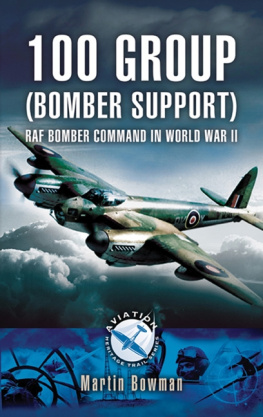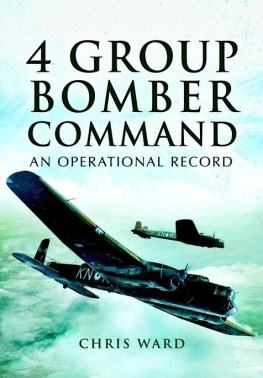INTO THE
NIGHT SKY
RAF MIDDLETON ST GEORGE:
A BOMBER AIRFIELD AT WAR
PAUL TWEDDLE

First published in 2007
The History Press
The Mill, Brimscombe Port
Stroud, Gloucestershire, GL 5 2 QG
www.thehistorypress.co.uk
This ebook edition first published in 2013
All rights reserved
Paul Tweddle, 2007, 2013
The right of Paul Tweddle to be identified as the Author of this work has been asserted in accordance with the Copyrights, Designs and Patents Act 1988.
This ebook is copyright material and must not be copied, reproduced, transferred, distributed, leased, licensed or publicly performed or used in any way except as specifically permitted in writing by the publishers, as allowed under the terms and conditions under which it was purchased or as strictly permitted by applicable copyright law. Any unauthorised distribution or use of this text may be a direct infringement of the authors and publishers rights, and those responsible may be liable in law accordingly.
EPUB ISBN 978 0 7524 9613 9
Original typesetting by The History Press
Acknowledgements or Proud Words on a Dusty Shelf
T his book has taken an inordinately long time to write and I have run up many debts of gratitude along the way. I am particularly grateful to the many men and women who were stationed at Middleton St George and gave up their time to speak to or correspond with me, often at some length. Their recollections form the very heart of this book. I have also benefited from the help and advice given by the 76, 78, 419/420/428 Squadron Associations and the Bomber Command Association. The Kamloops Museum and Archives supplied me with much useful and interesting information and I am grateful to Dr David Milobar of Vancouver for putting me in touch with it.
I would also like to thank Hazel Arrandale, Joan Marshall and Gwen Griffiths for their help with the typing and computer work, and Jonathan Falconer at Sutton for giving me this opportunity. Thanks are due to Pauline Calvert of the Northern Echo, Caroline Archer and Penny Smith for supplying photographs. Many friends have taken a much appreciated positive interest, notably Dr James Pulle, Drs Andrew and Margaret Yacoot and Mr Willie Murdock. Several years worth of boys and girls at Danes Hill School have also patiently endured snippets of modern military history popping up in their Latin lessons.
I have enjoyed unstinting support and encouragement from my mam Marjorie and my late dad Gordon, who, among other things, toiled patiently for countless hours on my behalf in Darlington library.
My wife Caroline has had to live with me and my bombers for far too long and has done so with amazing equanimity. She has made an incalculable contribution to this book and it is to her and to our little boy Benedict that I dedicate this work. Sine qua non.
Introduction
A large aircraft trundles along the perimeter track and turns to face the runway. It pauses briefly before, with engines screaming, it roars off down the tarmac, gathering speed until the wheels gently lift off the ground and it soars smoothly into the sky. On board a couple of hundred men and women, boys and girls, chatter excitedly on their way to a European holiday resort. They have just left an airfield once known as Middleton St George, commissioned in 1941 as a base for the Royal Air Force and later for the Royal Canadian Air Force. Back then, in the dark days of the Second World War, grimfaced young men hauled their Whitleys, Wellingtons, Halifaxes and Lancasters, heavily laden with bombs, into the deadly night skies over Occupied Europe and Nazi Germany.
Middleton St George was just one of dozens of Bomber Command bases but its contribution to the final victory and the efforts and sacrifices made by the men and women stationed there to achieve it deserve to be remembered. This book is intended to be a plain and straightforward operational history of Middleton St Georges role in the war, no more, no less. It draws upon the recollections, published and unpublished, of men and women who were stationed there, supplemented by official records held at the National Archives, Kew (formerly known as the Public Record Office), and the Public Archives of Canada. I only hope the words do the deeds justice.
A BRAVE NEW WORLD
Middleton St George was one cog in the vast machine that was Bomber Command in the Second World War. It was a fairly typical, ordinary airfield where hundreds of ordinary men and women laboured around the clock to carry out extraordinary actions, taking the war right to the heart of one of the most evil regimes in history. As much of what was being attempted had never been tried before, it is not surprising that errors were made. At the very cutting edge of technology, confronted by the hostile natural elements of the skies and hunted by a well-equipped, skilful and determined enemy, it is testimony to the courage of the men concerned that they achieved as much as they did.
The Strategic Air Offensive, in essence a scheme to remove an opponents capacity and, indeed, will to wage war effectively, grew out of the German Zeppelin and Gotha raids of the First World War and came to dominate both military and political thinking throughout the 1920s and 1930s. As Harold Macmillan wrote in his memoirs, We thought of air warfare in 1938 rather like people think of nuclear war today. The public long remembered Prime Minister Stanley Baldwins chilling statement made in the House of Commons on 10 November 1932: No power on earth can protect the man in the street from being bombed. Whatever people might tell him, the bomber will always get through. Living in the shadow of the bomber, it became widely accepted that there were only two effective defences against such a knock-out blow: first, to disarm, and secondly, to out-stick and out-punch an opponent. Britain tried the former and after the inevitable failure, switched to the latter in the mid-1930s.

The memorial stone on the lawn outside the former officers mess commemorating the wartime role of 419, 420 and 428 Squadrons, RCAF, 6 Group, Bomber Command. (C.J. Archer)
Plans were hurriedly drawn up for new, long-range heavy bombers and for their development, later codified as the Western Air Plans. This blueprint for the Strategic Air Offensive against Germany focused upon weakening the Luftwaffe and the German aircraft industry thereby protecting Britain from aerial assault and destroying Germanys heavy industry, oil industry, administrative and communication centres, transportation system, including shipping, and fatally undermining its willingness to fight. Target selection was by no means as random as it might first appear. Much of what the squadrons based at Middleton St George were doing must be placed within this historical context.
Plans are subject to revision and modification and the Air Ministry accepted that the day-to-day necessities and exigencies of war had to take precedence so that Bomber Command often found itself operating well beyond its original brief. It also had to admit that the Command initially lacked the technological means to carry out its own plans in any meaningful manner and, in many ways, its 6-year-long offensive is the story of the advances made by the boffins in the back rooms. The Bomber Command of May 1945 bore little resemblance to that of September 1939.
The men and women stationed at Middleton St George played their full part in that long offensive and the airfields battle honours chart the Commands and the wars progress the Battle of the Atlantic, the Thousand Bomber Raids, the Battle of the Ruhr, the Battle of Hamburg, the Battle of Berlin, the Normandy Campaign, operations against shipping, the V-weapons and the final assault upon Germany.
Next page














